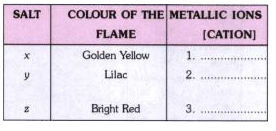When borax bead containing a small amount of metal salt is heated in reducing flame of bunser burner, the colour of the bead after heating was blue . The metal present in the salt would be
Manganese
Nickel
Cobalt
Chromium
The correct Answer is:C
To solve the question regarding the color of the borax bead after heating, we can follow these steps:
Step 1: Understand the Borax Bead Test
The borax bead test is used in qualitative inorganic analysis to identify the presence of certain metal ions. When borax (sodium tetraborate) is heated in a flame, it melts and can react with metal salts to produce colored beads.
Hint: Remember that the borax bead test is a qualitative analysis method used for detecting metal ions based on the color produced.
Step 2: Identify the Color Change
The question states that the borax bead turns blue after heating. This color change indicates the presence of a specific metal ion in the salt.
Hint: Different metals produce different colors when heated in a borax bead. Familiarize yourself with the common colors associated with various metals.
Step 3: Analyze the Given Options
The options given are:
- A) Manganese
- B) Nickel
- C) Cobalt
- D) Chromium
We need to determine which of these metals produces a blue color when heated in a borax bead.
Hint: Recall the specific colors associated with each metal when heated in a borax bead. This will help you eliminate options.
Step 4: Recall the Color Associations
- Cobalt: Produces a blue bead.
- Nickel: Produces a gray bead.
- Chromium: Produces a green bead.
- Manganese: Typically produces a colorless bead in a reducing flame.
Hint: Focus on cobalt, as it is known for producing a blue color in the borax bead test.
Step 5: Conclusion
Since the question specifies that the bead is blue after heating, the metal present in the salt must be cobalt.
Final Answer: The metal present in the salt would be Cobalt.
The borax bead test is used in qualitative inorganic analysis to identify the presence of certain metal ions. When borax (sodium tetraborate) is heated in a flame, it melts and can react with metal salts to produce colored beads.
The question states that the borax bead turns blue after heating. This color change indicates the presence of a specific metal ion in the salt.
The options given are:
- A) Manganese
- B) Nickel
- C) Cobalt
- D) Chromium
- Cobalt: Produces a blue bead.
- Nickel: Produces a gray bead.
- Chromium: Produces a green bead.
- Manganese: Typically produces a colorless bead in a reducing flame.
Since the question specifies that the bead is blue after heating, the metal present in the salt must be cobalt.
Topper's Solved these Questions
Similar Questions
A minute of cupric salt is heated on borax bead in reducing flame of bunsen burner, the colour of bead after cooling will be
View SolutionA salt imparts a yellow colour to a borax bead in an oxidising flame. What would be the colour of the bead in a reducing flame?
View SolutionA chemistry student trying to detect the metallic ion in a salt, makes a paste on a clean platinum wire loop of the salt with concentrated HCl. When he takes a small amount of this paste and keeps it in a non-luminous Bunsen flame, the colour of the flame changes to grassy green.He should, therefore, conclude that the metal is
View SolutionThe metallic ions (the cations) can be identify by performing flame test which is describe below.
"Make a paste of the given salt in concentrated hydrochloric acid. Load the paste on a clean platinum wire and introduce it in a non-luminous bunsen burner flame. Note the colour of the flame imparted by the flame. Tabulate your answer in the formate given below. The salt x imparts golden yellow flame. The salt y imparts lilac flame and the salt z imparts bright red flame.

View SolutionOn strongly heating, a blue salt leaves a black residue. Which of the following cations can be present in the salt?
View SolutionWhen a crystal having rock salt type geometry is heated in the presence of it's metal vapour then defect in it will be
View SolutionWhich of the following metal salts gives a red and opaque borax bead in the reducing flame (in cold)?
View Solution(i) You are provided with two test tubes containing an aqueous solution of carbonateand sulphite respectively. How will you identify them?
(ii) A colourless salt on heating, forms a white sublimate on the cooler sides of the lost tube. The gas evolved is colourless and has a pungent smell. It givos donse white fumes when a rod dipped in conc. HCl is brought near the mouth of the fest tube. Identify the basic radical present in the salt.
View SolutionWhich of the following will give the same colour in oxidising flame as well as in the reducing flame in borax bead test (when cold) ?
View SolutionState with equations what happens when borax is heated on a platinum wire loop and to resulting transparent mass, a mixture amount of CuO is added and the mixture is again heated.
(a) First in the oxidising flame and
(b) Then in the reducing flame of a Bunsen burner ?
View Solution
